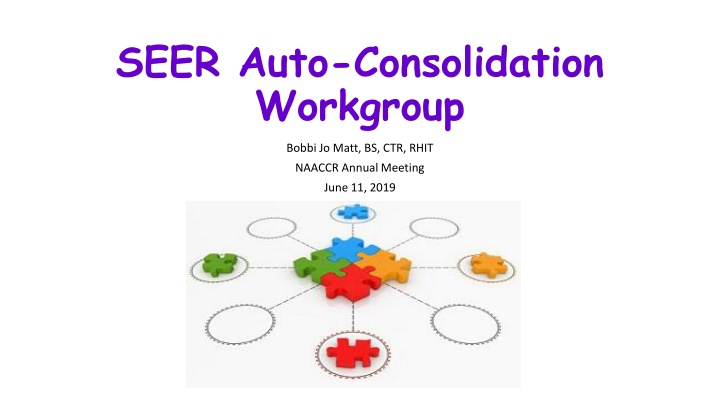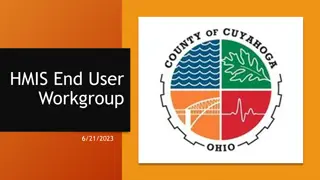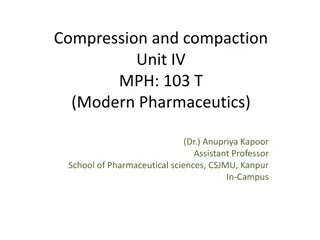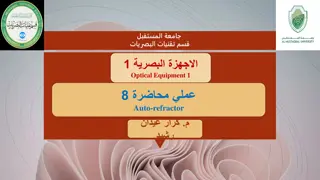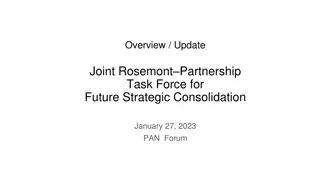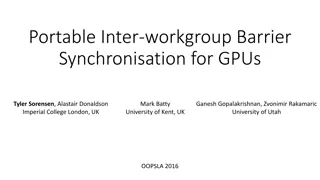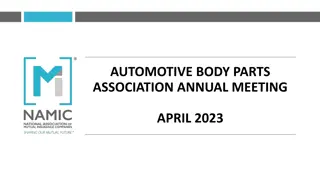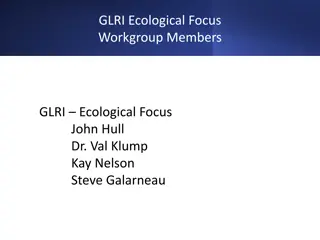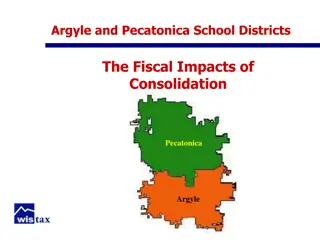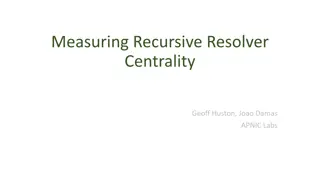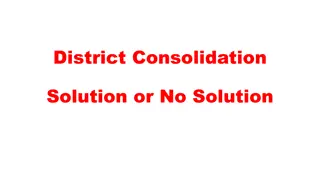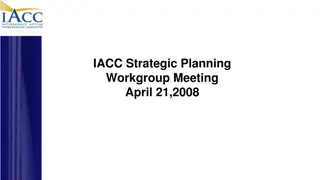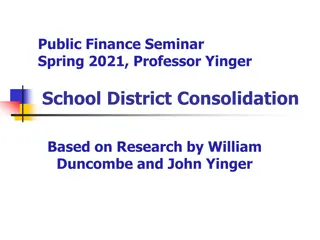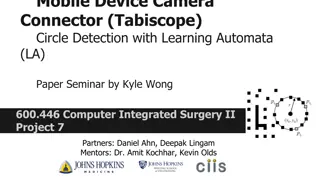SEER Auto-Consolidation Workgroup Objectives and Process
This content details the objectives, goals, workflow, and process of the SEER Auto-Consolidation Workgroup formed in May 2017. The workgroup aims to standardize processes for identifying tumor-related data fields for potential auto-consolidation and creating a standardized interpretation of data item rules. The process involves selecting data items, identifying coding instructions, developing logic, and testing methods across all registries to improve data consolidation efficiency.
Download Presentation

Please find below an Image/Link to download the presentation.
The content on the website is provided AS IS for your information and personal use only. It may not be sold, licensed, or shared on other websites without obtaining consent from the author.If you encounter any issues during the download, it is possible that the publisher has removed the file from their server.
You are allowed to download the files provided on this website for personal or commercial use, subject to the condition that they are used lawfully. All files are the property of their respective owners.
The content on the website is provided AS IS for your information and personal use only. It may not be sold, licensed, or shared on other websites without obtaining consent from the author.
E N D
Presentation Transcript
SEER Auto-Consolidation Workgroup Bobbi Jo Matt, BS, CTR, RHIT NAACCR Annual Meeting June 11, 2019
Objectives Goals Workflow/Process Accomplishments Work in Progress Questions
The Workgroup Formed May 2017 Participants from SEER registries, NCI and IMS Meets monthly via a Web call
Workgroup Goals Workgroup Goals To develop a standardized process to identify tumor related data fields for potential auto-consolidation To create and test standardized auto-consolidation logic for each data field To define and develop a standard interpretation of the data item rules
The Process The Process STEP 1: Select data items for potential auto-consolidation Reporting Source selected STEP 2: Identify all coding instructions applicable to consolidating the data item (Reference: SEER STORE AJCC NAACCR) Priority order for codes -> 1, 2, 8, 4, 3, 5, 6, 7 STEP 3: Identify any data items that may be used in the manual decision-making process Class of Case
The Process cont. The Process cont. STEP 4: Develop logic to identify the best value from the source records Information from step 2 & 3 incorporated into logic The priority order for codes Class of Case Example: Comparing Reporting Source field If incoming record has value of 1 -> a value of 1 will overwrite 2 unless the 2 is coming from analytic source and 1 is coming from non-analytic source
The Process cont. The Process cont. STEP 5: Develop methods to test logic STEP 6: Conduct test Executed across all registries Use manually consolidated data as the gold standard to: Identify weaknesses in proposed logic Shows ambiguity in guidelines
The Process cont. The Process cont. STEP 7: Analyze results Did the auto-consolidated value match the manually consolidate value? Did the logic correctly identify the correct source record value manual review missed? STEP 8: Make adjustments based on analysis Source records don t have data field under review DCO s vs MDO s
The Process cont. The Process cont. STEP 9: Re-Test (Step 6) STEP 10: Implementation Registry specific decision Timing Customize logic or Opt out Type of Reporting Source All registry s choice to just do based on priority order and run on new cases
Accomplishments Accomplishments Type of Reporting Source Implemented into SEER*DMS Diagnostic Confirmation Logic developed & Analyzed IMS testing and should be in production soon Determined further training is needed for Heme/Lymph tumors Lymph Vascular Invasion (LVI) Logic developed IMS testing in progress
Accomplishments cont. Accomplishments cont. Implemented automated solution to select known over unknown values 2018 SSDI s Mets at Diagnosis (6 data fields) Marital Status at Diagnosis Primary Payer at Diagnosis Developed priority list for drafting automation logic for required data fields Grouped data fields together
In Progress In Progress Develop logic for Known over Known: Marital Status at Diagnosis Primary Payer at Diagnosis Mets at Diagnosis (6 data fields)
Discussion Topics Discussion Topics Class of Case Used frequently in consolidating Not required by all standard setters Not consistently coded Trust in the Source Record While an abstract may pass edits, there may be inconsistencies within the abstract that are not identified by edits Inconsistencies, unless corrected, may inadvertently be selected as the correct code during auto-consolidation
Source Record Validation Source Record Validation - - Sub Sub- -Workgroup Workgroup Created in response to the discussion on trust in the source record Purpose is to develop logic for ensuring the source records are accurate Participants are the same as Auto-Consolidation workgroup Group meets every other month (alternating with Auto- Consolidation workgroup)
Source Record Validation Source Record Validation - - Goals Goals Phase 1 Define a minimal set of edits for source records (beyond existing record edits) Define strategies for handling fields with coding errors and/or edit failures
Source Record Validation Source Record Validation - - Goals cont. Goals cont. Phase 2 Concurrent with defining auto-consolidation logic, run queries to evaluate common issues in the data items used as input to the logic Identify global fixes for data items (as appropriate) Define rules for targeted visual editing Discuss development of a workflow to reject records with errors and/or provide feedback to registries
Source Record Validation Source Record Validation Future topics Determining how Class of Case is used and what role it plays in auto-consolidation Future topics Data items from new data sources in regards to consolidation Claims Pharmacy etc.
Auto-Consolidate Workgroup Linda Coyle, IMS Suzanne Adams, IMS Frances Ross, CTR, Kentucky Cheryl Moody, BA, CTR, California Kacey Wigren, CTR, RHIT, Utah
